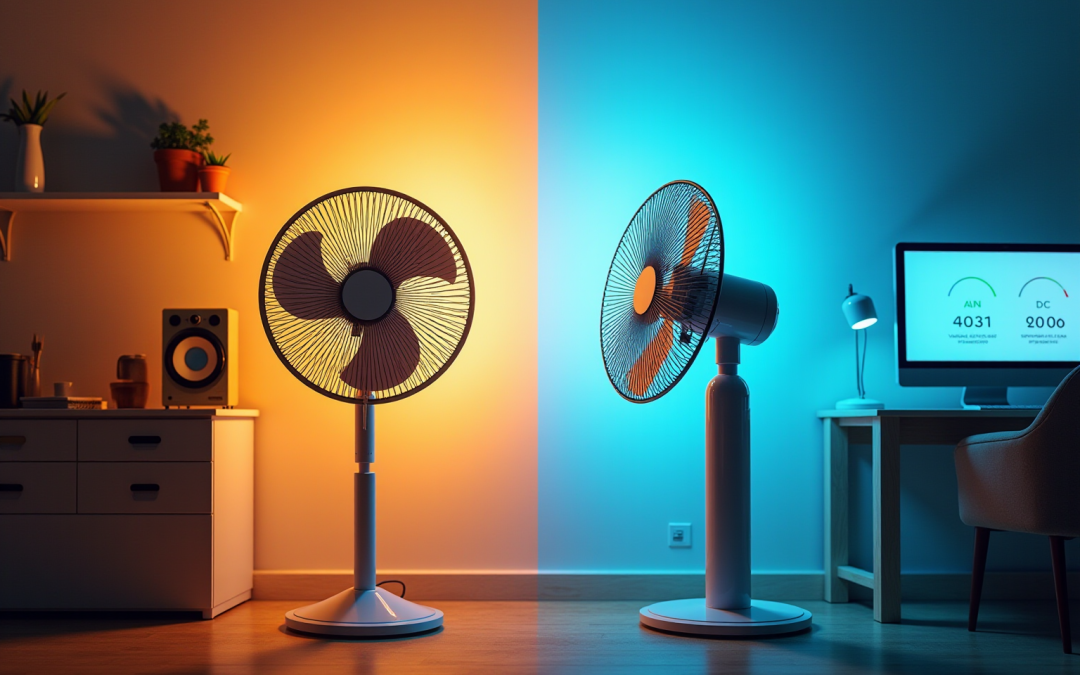Overview
The article provides a comprehensive comparison of DC fans and AC fans, emphasizing their distinct mechanisms, advantages, disadvantages, and market trends—critical information for electronics engineers in selecting the appropriate fan type. It elucidates that while AC fans are generally more cost-effective and simpler to install, DC fans present significant benefits in energy efficiency, quieter operation, and advanced control options. This makes DC fans increasingly favored in applications that prioritize energy conservation.
Introduction
Understanding the nuances between AC and DC fans is essential for electronics engineers navigating the complexities of modern cooling solutions. As the demand for energy-efficient technologies escalates, the choice between these two fan types can significantly influence both performance and operational costs. Engineers must consider several critical factors when weighing the simplicity and affordability of AC fans against the advanced efficiency and control offered by DC fans. By exploring these key comparisons, we uncover not only the mechanics behind each type but also the broader implications for sustainability and innovation in engineering design.
Understand AC and DC Fans: Key Definitions and Mechanisms
AC devices operate on alternating current, which means the electrical current changes direction periodically. This characteristic leads to a simpler engine design, generally resulting in a more durable and economical solution. In contrast, when comparing DC fans vs AC fans, it is clear that DC fans utilize direct current, where the electrical flow remains constant. This design permits advanced control of movement, enabling features such as variable speed settings and quieter operation. The construction of DC devices often includes brushless designs, which reduce wear and tear, thereby improving longevity and efficiency. Understanding these mechanisms is crucial for engineers when selecting the appropriate fan type for specific applications.
Key Differences in Mechanisms
- AC Fans: Utilize a simpler motor design, generally resulting in lower initial costs but higher energy consumption.
- DC Enthusiasts: Incorporate advanced motor technology that enables improved power efficiency and management, using up to 70% less power compared to conventional AC motor devices, although at a greater initial expense. Gagner-Toomey’s extensive range of DC input Tube Axial units and Centrifugal Blowers, available in sizes from 15 to 280mm and 15 to 225mm respectively, exemplifies this innovation in cooling solutions.
Market Insights
As of 2025, the market share for AC fans remains significant; however, the demand for DC fans is rapidly increasing due to their energy efficiency and advanced features. This shift is driven by rising global temperatures and the need for sustainable cooling solutions in various applications, including consumer electronics and automotive systems.
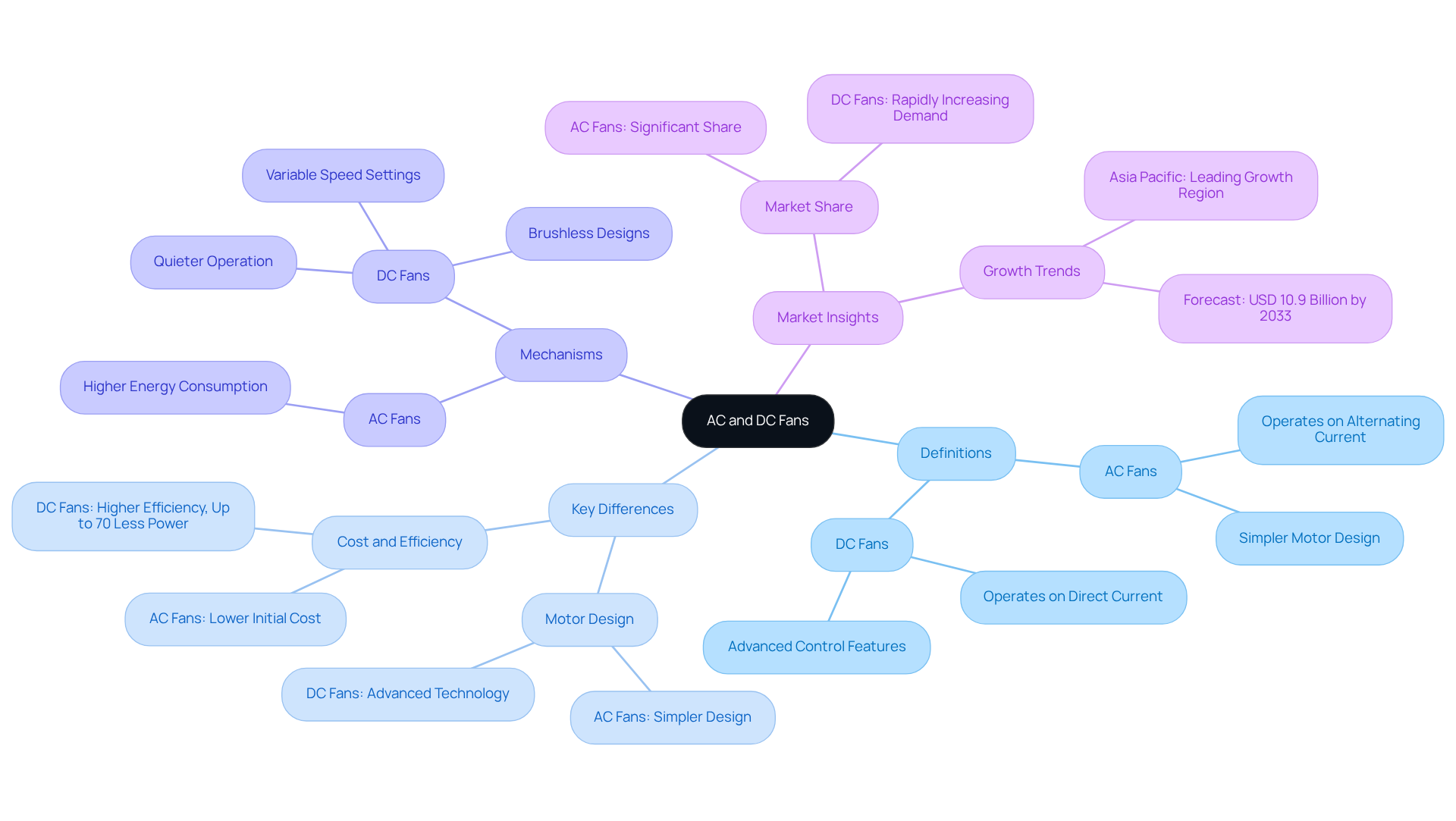
Evaluate Advantages and Disadvantages of AC and DC Fans
Evaluate Advantages and Disadvantages of AC and DC Fans
Advantages of AC Fans
- Cost-Effective: AC fans are generally more affordable to purchase and install, making them an attractive option for budget-conscious consumers.
- Simplicity: Their uncomplicated engine design contributes to easier maintenance, appealing to those who prefer low-maintenance solutions.
- Durability: AC motors are robust and can handle varying loads without significant wear, ensuring longevity in diverse applications.
Disadvantages of AC Fans
- Energy Consumption: AC fans typically consume more power, with operational costs significantly higher than those of DC fans. For instance, a standard AC fan can consume between 500 to 750 watts per hour, leading to increased electricity bills, especially when used extensively. Running a ceiling fan for 24 hours in Texas costs approximately 31 cents, highlighting the cost implications of continuous use.
- Noise Levels: AC motors are often noisier than their DC equivalents, which can be a drawback in quiet settings, such as bedrooms or offices.
Advantages of DC Fans
- Energy Efficiency: DC fans can use up to 70% less energy than AC fans, resulting in substantial savings on electricity bills. This efficiency is particularly beneficial in regions with high energy costs, where running a ceiling fan can cost as little as 31 cents per day. Additionally, using a fan with a higher thermostat setting can save nearly $100 a month on electricity compared to running an AC unit.
- Variable Speed Control: They offer more precise airflow control, allowing users to customize settings for enhanced comfort and efficiency. Many DC enthusiasts arrive with six or more speed settings, offering versatility for various cooling requirements.
- Quieter Operation: DC motors typically function at reduced noise levels, making them suitable for home and office settings where minimizing sound is essential.
Disadvantages of DC Fans
- Higher Initial Cost: The upfront cost of DC fans is typically higher than that of AC fans, which may deter some consumers despite the long-term savings.
- Complexity: The more intricate motor design of DC units can lead to higher maintenance requirements, potentially complicating repairs and servicing. This complexity may result in increased servicing needs compared to the simpler AC fan designs.
- Expert Insights: According to Isaac Jamieson, a skilled electrician, “DC appliances use up to 70% less power than their AC equivalents, making them a superb option for households mindful of consumption.” This highlights the significant advantages of DC fans in terms of energy efficiency.
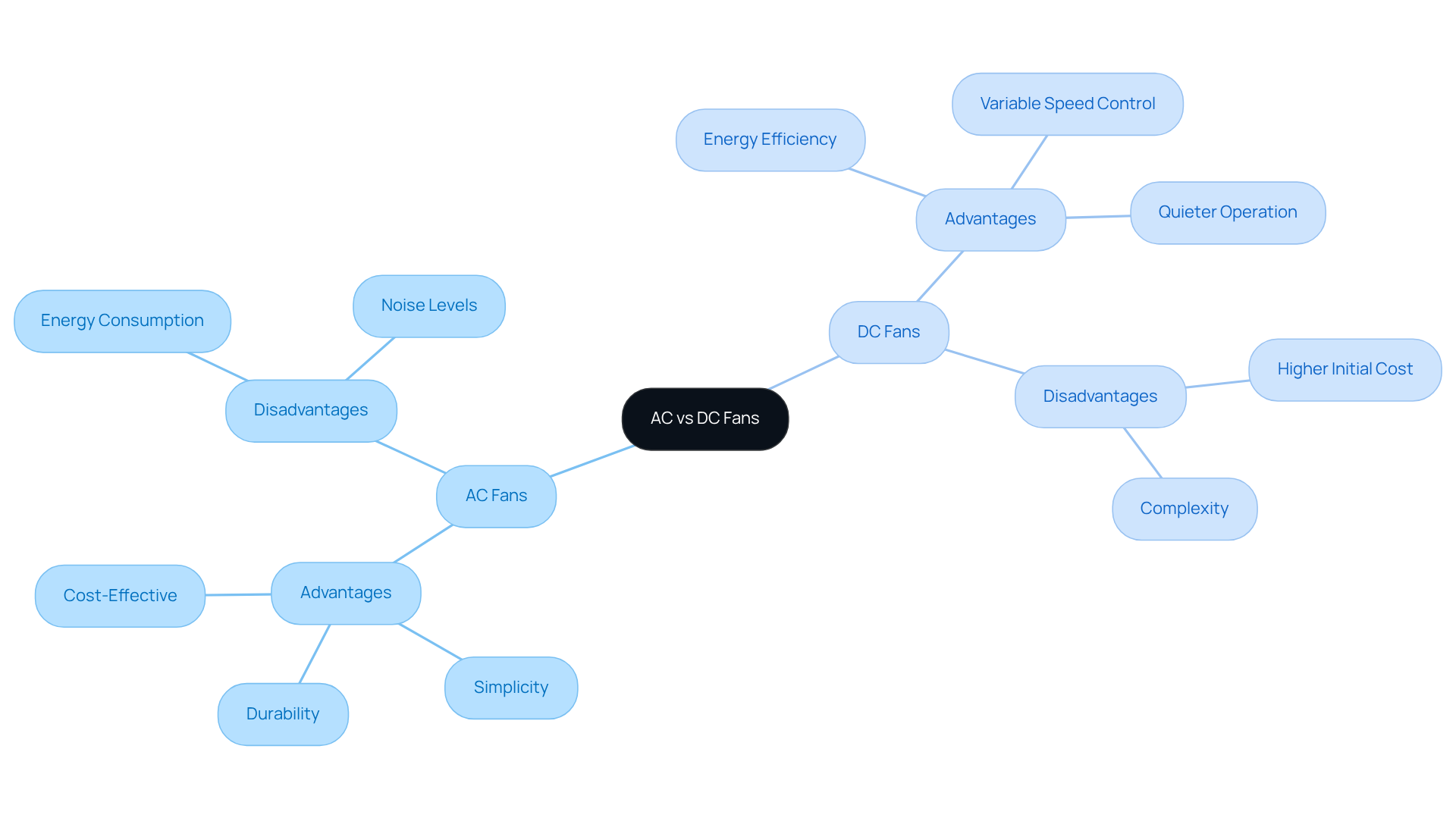
Consider Installation, Maintenance, and Cost Factors for AC vs DC Fans
Installation Factors
- AC Fans: Generally easier to install due to their straightforward wiring and motor design. They can be directly connected to standard electrical outlets without the need for additional components.
- When considering DC fans vs AC fans, installation may necessitate a transformer to convert AC to DC, which adds a layer of complexity. However, many modern DC fans come equipped with integrated drivers that streamline the installation process. Moreover, DC fans typically operate at lower voltages (5V, 12V, and 24V), an important factor for both safety and installation complexity.
Maintenance Considerations
- AC Fans: Require regular inspections for wear and tear, particularly in high-use environments. Maintenance is generally uncomplicated due to the simplicity of the engine design.
- DC Fans: While they may demand less frequent maintenance owing to their brushless design, they can be more susceptible to voltage fluctuations, necessitating vigilant monitoring of power supply conditions. Additionally, DC motors provide a more stable, constant torque across various speeds, enhancing performance stability during operation.
Cost Factors
- Initial Costs: AC fans are typically less expensive to acquire, making them appealing for budget-conscious projects. Conversely, while DC fans vs AC fans may have a higher initial cost, DC fans provide long-term savings through their efficiency in power consumption.
- Operational Costs: Over time, the lower power usage of DC devices can lead to significant savings, counterbalancing their higher upfront costs. In fact, DC ceiling fans are 70% more energy efficient than their AC counterparts, underscoring the importance of considering total cost of ownership in decision-making.
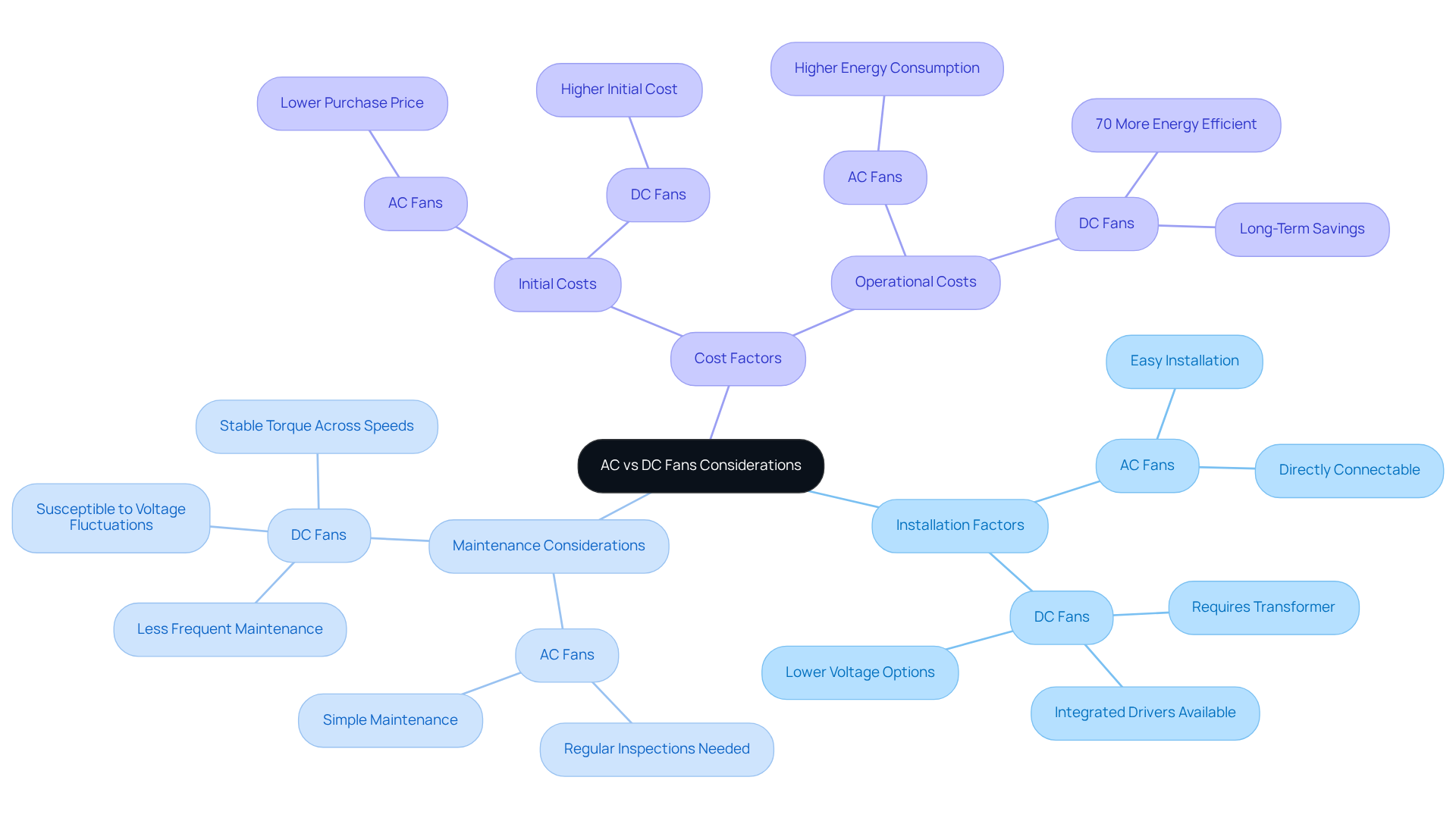
Performance Comparison: Efficiency, Noise, and Control
Performance Comparison: Efficiency, Noise, and Control
Efficiency
AC fans typically exhibit lower efficiency, particularly at reduced speeds, resulting in increased operational costs over time. For instance, a 60-inch AC ceiling fan consumes approximately 60-75 watts and costs around $10 for the same airflow that a DC fan would achieve for about $3, illustrating the differences in efficiency between DC fans vs AC fans. In contrast, when comparing DC fans vs AC fans, the former are renowned for their high efficiency, particularly at variable speeds. They can modulate power consumption based on the required airflow, making them ideal for energy-conscious applications. A 25-watt DC fan, for example, can produce the same airflow as a 100-watt AC fan, illustrating the energy savings in the debate of DC fans vs AC fans.
Noise Levels
AC fans generally produce more noise due to their motor design and operational characteristics. They often generate electromagnetic interference, which can disrupt sensitive equipment, making this a critical consideration in environments where quiet operation is paramount. Conversely, when comparing DC fans vs AC fans, the former operates with minimal noise, making them suitable for residential, office, and other noise-sensitive applications. Their brushless motor design contributes to quieter operation, particularly beneficial in settings like medical instruments and telecom switches. As noted by Sam Pelonis, DC fans are “an excellent option for applications such as medical instruments, telecom switches, or car entertainment systems, where noise could be a nuisance.”
Control Options
AC fans offer limited speed control options, often necessitating manual adjustments or basic wall controls, which can restrict flexibility in airflow management. On the other hand, in the debate of DC fans vs AC fans, DC fans provide advanced control features, including remote control and smart home integration, allowing for precise adjustments to airflow and energy consumption. This capability enhances user experience and operational efficiency, making DC fans a preferred choice for modern applications.
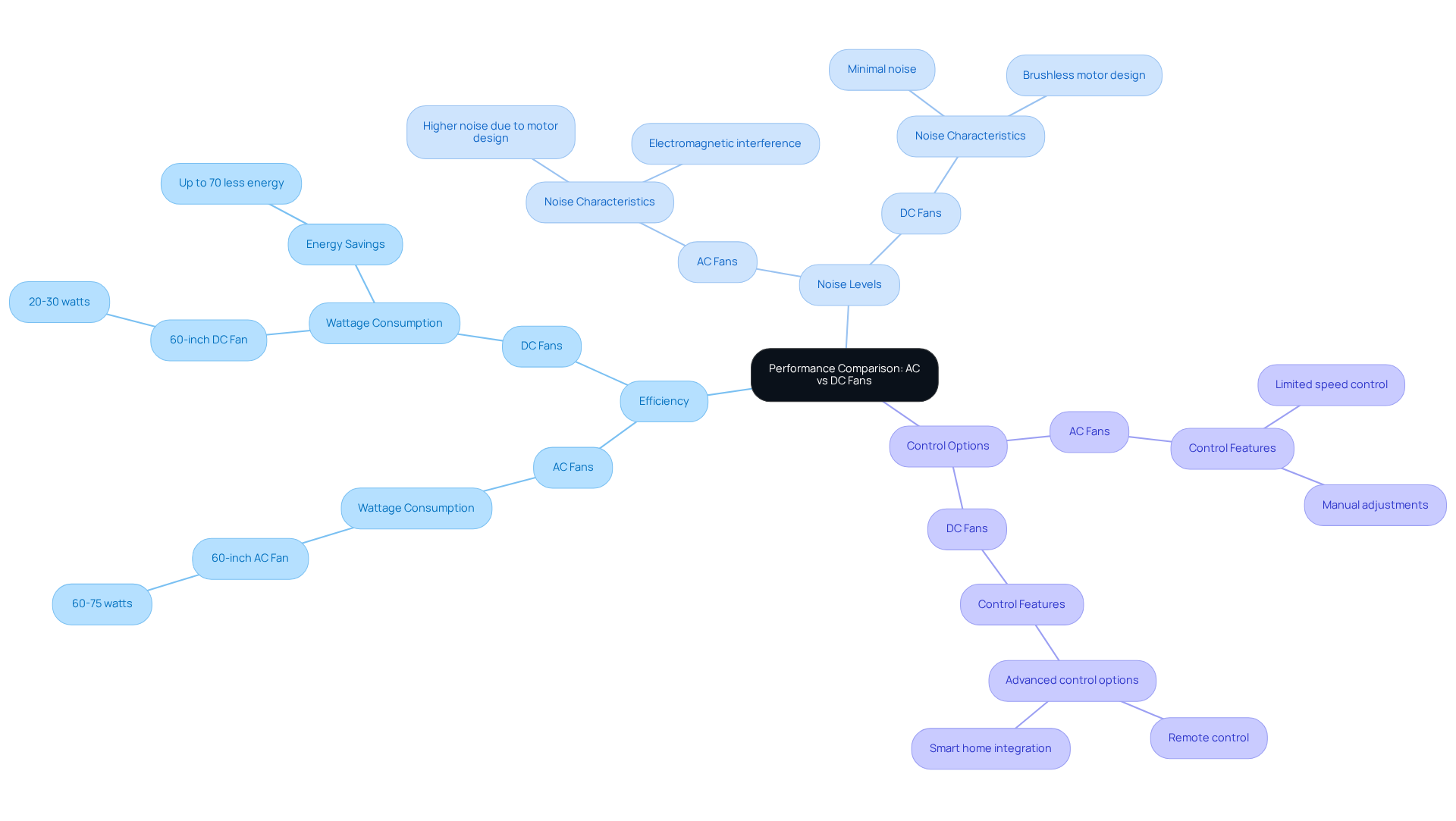
Conclusion
The comparison between DC fans and AC fans offers crucial insights for electronics engineers and consumers alike. AC fans present a straightforward design and lower initial costs; however, they are associated with higher energy consumption and noise levels. Conversely, DC fans, despite their higher initial price, deliver significant advantages in energy efficiency, quieter operation, and advanced control features that align with modern demands.
This article highlights the key differences between the two fan types, including their mechanisms, advantages, and disadvantages. AC fans are acknowledged for their cost-effectiveness and durability, while DC fans distinguish themselves through energy savings and customizable settings. The growing market demand for DC fans emphasizes the necessity of sustainable solutions, particularly in the context of rising global temperatures.
Ultimately, the decision between AC and DC fans should be informed by specific application needs, budget considerations, and long-term operational costs. As energy efficiency gains importance across various sectors, selecting DC fans may not only result in lower electricity bills but also contribute to a more sustainable future. Making an informed choice in this domain can significantly influence both performance and environmental footprint.
Frequently Asked Questions
What is the main difference between AC and DC fans?
AC fans operate on alternating current, which causes the electrical current to change direction periodically, leading to a simpler and more durable motor design. In contrast, DC fans use direct current, allowing for advanced control features such as variable speed settings and quieter operation.
How do the motor designs of AC and DC fans differ?
AC fans have a simpler motor design, which typically results in lower initial costs but higher energy consumption. DC fans incorporate advanced motor technology, which improves power efficiency and management, using up to 70% less power compared to conventional AC motors.
What are the advantages of DC fans over AC fans?
DC fans offer improved energy efficiency, advanced control features like variable speed settings, and quieter operation due to their brushless designs that reduce wear and tear, enhancing longevity and efficiency.
What types of DC fans are available in the market?
Gagner-Toomey offers a range of DC input Tube Axial units and Centrifugal Blowers, available in sizes from 15 to 280mm and 15 to 225mm, respectively, showcasing innovation in cooling solutions.
What is the current market trend for AC and DC fans?
As of 2025, while the market share for AC fans remains significant, the demand for DC fans is rapidly increasing due to their energy efficiency and advanced features, driven by rising global temperatures and the need for sustainable cooling solutions in various applications.

